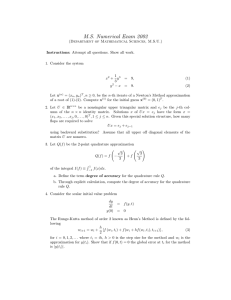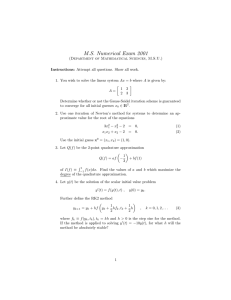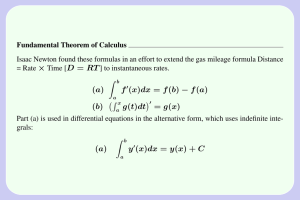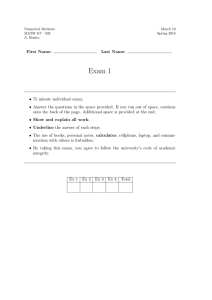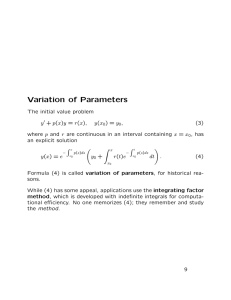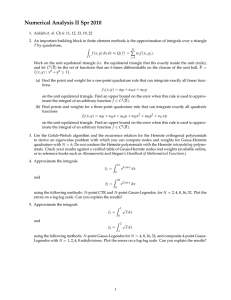Fall 2015: Numerical Methods I Assignment 6 (due Dec. 8, 2015)
advertisement
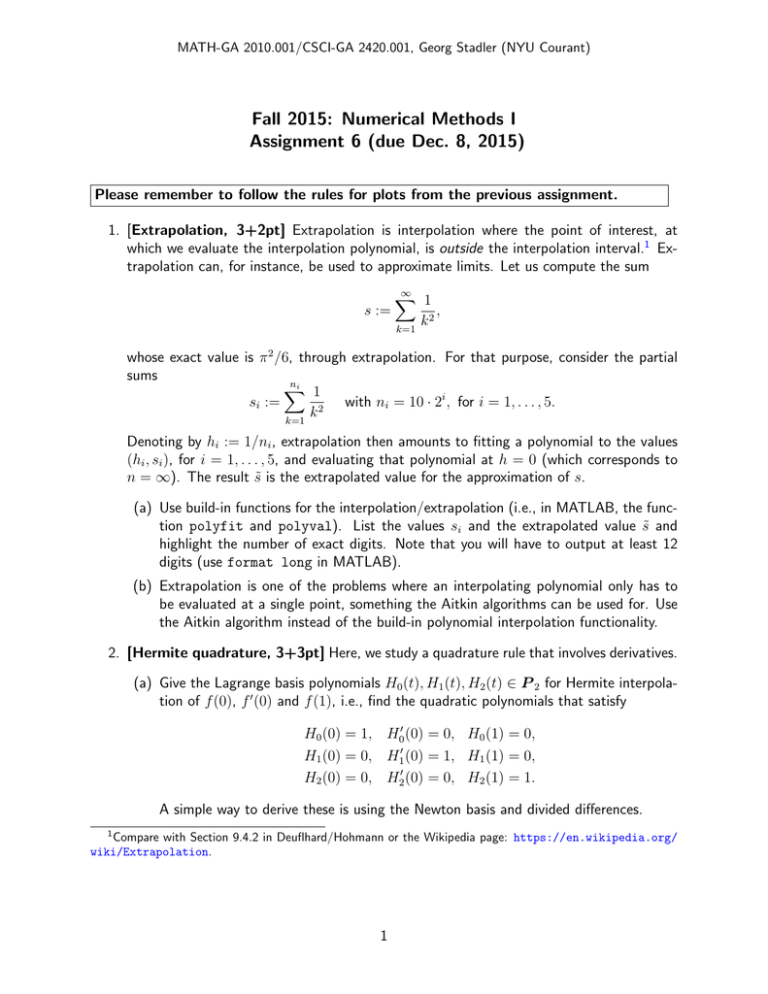
MATH-GA 2010.001/CSCI-GA 2420.001, Georg Stadler (NYU Courant) Fall 2015: Numerical Methods I Assignment 6 (due Dec. 8, 2015) Please remember to follow the rules for plots from the previous assignment. 1. [Extrapolation, 3+2pt] Extrapolation is interpolation where the point of interest, at which we evaluate the interpolation polynomial, is outside the interpolation interval.1 Extrapolation can, for instance, be used to approximate limits. Let us compute the sum s := ∞ X 1 , 2 k k=1 whose exact value is π 2 /6, through extrapolation. For that purpose, consider the partial sums ni X 1 si := with ni = 10 · 2i , for i = 1, . . . , 5. 2 k k=1 Denoting by hi := 1/ni , extrapolation then amounts to fitting a polynomial to the values (hi , si ), for i = 1, . . . , 5, and evaluating that polynomial at h = 0 (which corresponds to n = ∞). The result s̃ is the extrapolated value for the approximation of s. (a) Use build-in functions for the interpolation/extrapolation (i.e., in MATLAB, the function polyfit and polyval). List the values si and the extrapolated value s̃ and highlight the number of exact digits. Note that you will have to output at least 12 digits (use format long in MATLAB). (b) Extrapolation is one of the problems where an interpolating polynomial only has to be evaluated at a single point, something the Aitkin algorithms can be used for. Use the Aitkin algorithm instead of the build-in polynomial interpolation functionality. 2. [Hermite quadrature, 3+3pt] Here, we study a quadrature rule that involves derivatives. (a) Give the Lagrange basis polynomials H0 (t), H1 (t), H2 (t) ∈ P 2 for Hermite interpolation of f (0), f 0 (0) and f (1), i.e., find the quadratic polynomials that satisfy H0 (0) = 1, H00 (0) = 0, H0 (1) = 0, H1 (0) = 0, H10 (0) = 1, H1 (1) = 0, H2 (0) = 0, H20 (0) = 0, H2 (1) = 1. A simple way to derive these is using the Newton basis and divided differences. 1 Compare with Section 9.4.2 in Deuflhard/Hohmann or the Wikipedia page: https://en.wikipedia.org/ wiki/Extrapolation. 1 (b) For numerical integration on the interval [0, 1], find weights α1 , α2 , α3 such that the quadrature formula ˆ ) := α1 f (0) + α2 f 0 (0) + α3 f (1) I(f integrates polynomials p ∈ P 2 exactly. Hint: Use that the Hermite polynomials H0 , H1 , H2 are a basis of P 2 , i.e., it suffices if Iˆ is exact for these Hi . 3. [Trapezoidal and Simpson sum, 4+2+2pt] Write functions trapez(f,x) and simpson(f,x) to approximate integrals Z b f (t) dt I(f ) = a using the trapezoidal and Simpson’s rules on each sub-interval Ii := [xi , xi+1 ], i = 0, 1, . . . , N − 1, where we assume that these sub-intervals cover [a, b] and have no overlap except the sub-interval boundary points xi . The input vector to the functions should be x = (x0 , . . . , xN ), i.e., the vector of sub-interval boundaries, and f is either a function handle2 or the vector f = (f (x0 ), . . . , f (xN )). Note that simpson() also requires the function values at the mid points of each interval, i.e., if f is a vector, it must include the values f ((xi+1 + xi )/2) and must thus be of size 2N + 1. (a) Hand in code listings of these functions, and use them to approximate the integrals Z 1 Z 1 √ 4 x dx, x dx. 0 0 Compare the numerical errors for uniformly spaced points xi = ih, i = 0, . . . , N , h = 1/N for both quadrature rules. Try different N and plot the quadrature errors versus N in a double-logarithmic plot. (b) Estimate the error behavior by fitting cN κ , with c, κ ∈ R to the quadrature errors. To avoid having to solve a nonlinear least squares problem for c and κ, apply the logarithm to cN κ and solve a linear least squares problem for the parameters d := log(c) and κ. R1√ (c) Propose non-uniform interval points xi to faster approximate 0 x dx, and plot your numerical result for different N . Again, estimate d and κ. 4. [Hierarchical Lobatto quadrature, 3+2pt] Gauss3 quadrature chooses the quadrature point location and the quadrature weights such that a high order approximation is achieved with a minimal number of points. The Gauss quadrature points for an interval [a, b] do not include the beginning and end points a and b. It is often convenient if these points are included. When not all points are allowed to vary but the location of some points is fixed, the corresponding quadrature rules are called Gauss-Lobatto rules. Let us compute such 2 See http://www.mathworks.com/help/matlab/matlab_prog/creating-a-function-handle.html if you are not familiar with that concept. 3 In this example, we use “Gauss quadrature” short for Gauss-Legendre quadrature, since we use the integral weight function ω ≡ 1, and the corresponding orthogonal polynomials are the Legendre polynomials. 2 Gauss-Lobatto points and corresponding quadrature weights for the interval [−1, 1]. Due to the symmetry, the quadrature formula for 4 nodes is: Iˆ1 (f ) = ω1 (f (−1) + f (1)) + ω2 (f (−t2 ) + f (t2 )), with to be determined weights ω1 , ω2 and the interior node location t0 . Because of symmetry, the monomials with odd degree are integrated exactly by the above formula. Since there are 3 parameters, we hope that we can choose them to integrate the even monomials 1, x2 , x4 exactly. (a) Give the set of nonlinear equations needed to be satisfied by ωi , ω2 and t2 to integrate the first three even monomials exactly, and solve it. You should be able to do this analytically.4 (b) Often, one is interested in an adaptive quadrature rule that allows to add quadrature points while re-using the quadrature points from a less accurate rule, where the function has already been evaluated.5 Thus, let us try to extend the above quadrature rule by adding internal nodes, while re-using the point t2 from above. We will add three points: Due to symmetry, one must lie at the center (t = 0), and the other two added points must be symmetric around the center, such that the new quadrature rule becomes: Iˆ2 (f ) = ω3 (f (−1) + f (1)) + ω4 (f (−t2 ) + f (t2 )) + ω5 (f (−t3 ) + f (t3 )) + ω6 f (0). Note that t2 is fixed but the corresponding weight ω4 can be different compared to the quadrature formula Iˆ1 . Thus, the free variables in Iˆ2 are ω3 , ω4 , ω5 , ω6 and t3 , and we can hope to integrate the monomials 1, x2 , x4 , x6 , x8 exactly. Specify the corresponding nonlinear system. (c) [2pt extra credit] Solve this nonlinear system for the five parameters using Newton’s method. 4 Note that a Gauss rule with 4 points and 4 weights allows to integrate polynomials up to order 7 exactly. This Gauss-Lobatto (or Gauss-Legendre-Lobatto) rule, which fixes two node locations, only integrates polynomials up to order 5 exactly. This, namely that Gauss quadrature is two orders more accurate than Lobatto-Gauss quadrature, remains true also for higher-order quadrature. 5 Function evaluation is usually the most expensive step in numerical quadrature, i.e., the target is to minimize the number of required evaluations of f while obtaining a good approximation to the integral. 3
